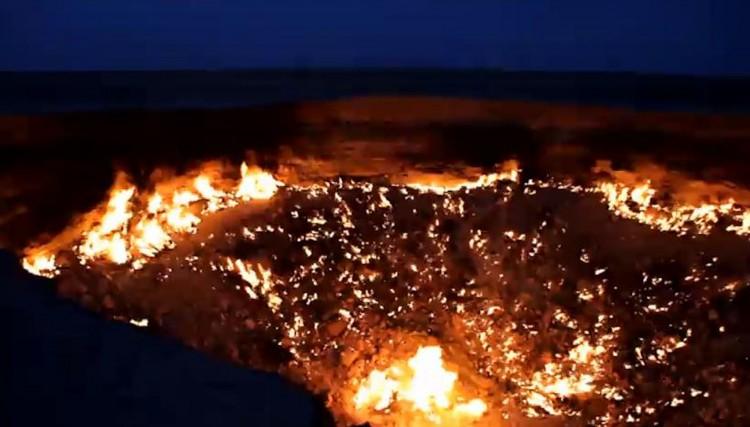‘Gates of Hell’ Burning in the Desert of Turkmenistan
A crater in the desert not far from the village of Derweze (also known as Darvaza), Turkmenistan, spews toxic gases and has been burning for decades, earning it the name “Gates of Hell.”
In 1971, when the region was under the reign of the former Soviet Union, a Soviet drilling rig hit an underground cavern, which collapsed into a pit about half a mile across, according to Jesse Allen, Earth Observatory data visualizer for the National Aeronautics and Space Administration (NASA).
The pit was set afire with the hopes of burning off the toxic gases, and the fire was expected to go out shortly afterward. Tourists are mesmerized by the flames of the burning pit to this day.
Robert Hird, a geologist at Cambridge University, camped near the pit and wrote about his encounter with the “Gates of Hell” on the Global Education Network website on January 1, 2012: “The bleak and unforgiving landscape was a stark contrast to the gleaming white metropolis of Ashgabat, the capital city of Turkmenistan, from which I had set out from earlier in the day.
Recommended: ‘Gate to Hell’ in Turkey Found By Archaeologist
“I spent most of the time at the crater’s edge, mesmerized by the hissing flames emitted from tiny fissures scattered around the crater’s base and occasional blasts of hot air as the wind changed direction.”
‘Gates of Hell’ Sinkhole in Guatemala
A sinkhole more than 200-feet deep opened up in Guatemala City in May 2010. It was called the “Gates of Hell” by many.
In a March 5, 2013 Q&A on sinkholes, National Geographic’s Jeremy Berlin answers the question: “What is the biggest sinkhole on record? The deadliest? The costliest in terms of property or infrastructure damage?”
He mentions only three sinkholes in his answer, and the “Gates of Hell” is one of them: “The one in Guatemala in 2010—that was just an incredible, incredible hole that looked like it was bottomless. To [geologists], that one is probably one of the more spectacular.”
“Probably the most spectacular one in the U.S. was the one in Winter Park, Florida, in 1981, where the Porsches [at a local dealership] fell into it and it took up a whole city block,” Berlin continues. “When we scientists talk about spectacular sinkholes, that one usually tops the list. And the Daisetta one in Texas, because that was one of the first ones caught on video—you could watch it happen.”
Recommended: Recent Sinkholes and Why They Form
The sinkhole in Guatemala swallowed a clothing factory. It was caused by tropical storm Agatha’s rains.
Sam Bonis, a geologist at Dartmouth College in New Hampshire, told National Geographic in June 2010 that it should not actually be considered a sinkhole, because the term “sinkhole” should only apply to the natural phenomenon of an underground cavern that has collapsed, while in Guatemala City burst drainage pipes likely cause the massive crater.
He said there is no scientific term for the Guatemala City chasm.
“Gates of Hell” will have to do.
Nyalam, Tibet
Nyalam was long known as the “Gate of Hell” among Nepalese traders for the treacherous conditions of the trail from the town of Nyalam, Tibet, into Nepal. The road was reconstructed in 2008, but the pass still has a unique character, according to accounts by travel bloggers.
As Jason and Carrie Stone went through the pass from northern Nepal into Tibet in September 2010, their Travelblog.org account states: “Once you leave Nyalam, the scenery completely changes. The barren mountains and fields turn to lush green with evergreen trees and lots of waterfalls from the snow melt of the Himalayans.”
Mark Horrell, in his blog post from April 11, 2012, describes Nyalam: “It’s cold and damp, and a grey mist hangs in the air, air that’s already thin because the altitude here is 3,500 metres [11,480 feet]. Wood smoke drifts from doorways and mixes with the mist, and the atmosphere is unpleasant.
“Streams of dirty water slide down the hill on each side of the street. Dark brown hills rise above a town which sits on a hill high above a deep river gorge, a continuation of the Bhote Khosi river which we followed up from Nepal yesterday.”
Recommended: Special Topic: Repression in Tibet
He notes, as do other travel bloggers, that the Chinese regime makes it quite difficult to enter Tibet.
Horrell writes of the many travelers in Nyalam at the time, all eager for the chance to visit Tibet: “Only last week Tibet was closed to visitors. As soon as the Chinese government opened the borders there was a flurry of people applying for visas.”





